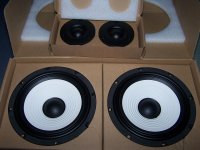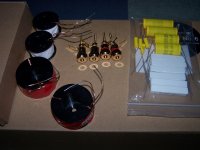Room gain is about how stiff your walls are and how many leaks it has (a window or door would be a leak)
dave
dave
I can spot the 2db peak you are speaking of. What would that actually be like to listen to though, would that small range of frequency be noticeably louder than the rest?
Can any of you suggest any good Loudspeaker design books that you have read that helped you along the way?
The 2dB peak does not occur in the real world but only in the modelling software. Years ago I found the the modelled result did not relate to what I was hearing or measuring. I found I was continually shortening the port to achieve the target result. I found some information via Ralph Waters' designs (who started Richter and Subsonic) as well as some old Vifa data sheets which provided some clues in real world port tuning. In effect I was reducing the port length by multiplying the modelled result by 0.7.
Troels has an interesting article on this.
Troelsgravesen vent tuning
The Fb=44Hz I suggested actually give us around Fb=38Hz which has a hump less than 1dB. I have a personal preference for a small hump on bookshelf speakers. It's all about personal taste.... sealed, vented with hump or smoother roll off. It's up to the builder to try and see what suits as it's not a one size fits all. There's no such thing as correct or incorrect as speaker design is all about compromises and choices to achieve a goal.
For a port I would use 51mm as a minimum to keep port noise down (vent velocity). WinISD is not very good at giving accurate port lengths. If you go too large in diameter then the port length becomes too long to fit in the box. You generally choose a diameter that gives an acceptable vent velocity with the expected amp power usage and driver power handling.
For a book look at "The Loudspeaker Design Cookbook" by Vance Dickason. It's not an easy read and takes a long time or many designs before the penny drops. Dan has it for sale at Darcher Audio.
That article was very helpful.
So if I was to use a 51mm port, I would use this equation with these values (assuming that I build a 15 litre enclosure).
Lv =(23562.5*Dv^2*Np/(Fb^2*Vb))-(k*Dv)
Lv = (23562.5*5.1^2*1/(44^2*15))-(.732*5.1)
Lv = 17.4 cm
Taken from the article and as per above suggestion.
Lv = 17.4 x 0.7
Lv = 12.2 cm
So if I am to use a 51mm diameter port, it is to be 122mm long, correct?
There is one aspect of the equation that I do not properly understand, how do you pick a suitable Fb value? For example, why isn't it set at the lowest frequency that the speaker can produce a sound?
So if I was to use a 51mm port, I would use this equation with these values (assuming that I build a 15 litre enclosure).
Lv =(23562.5*Dv^2*Np/(Fb^2*Vb))-(k*Dv)
Lv = (23562.5*5.1^2*1/(44^2*15))-(.732*5.1)
Lv = 17.4 cm
Taken from the article and as per above suggestion.
From practical experience I have learned to multiply the vent length by 0.6-0,7 to get the targeted Fb
Lv = 17.4 x 0.7
Lv = 12.2 cm
So if I am to use a 51mm diameter port, it is to be 122mm long, correct?
There is one aspect of the equation that I do not properly understand, how do you pick a suitable Fb value? For example, why isn't it set at the lowest frequency that the speaker can produce a sound?
We choose an Fb to achieve a desired roll off, port gain, F3, F6, port velocity etc. Determining ports via formulae only doesn't give a picture on what is happening. Rarely is a design used where the software optimum values used.... we shape to suit the application and taste.
In your example the 174mm port (Fb=44Hz) is the correct length as the 0.7 factor has already been considered. It's a corrected length for a 247mm port (Fb=38Hz).
For ports use 51mm PVC pipe (sewer 50NB class SH) available from plumbing or hardware suppliers. You can tune a box with the port outside the box and install various lengths until the target is reached. Then it's installed inside the box and the variation to Vb is minimal and not worth worrying about.
Send me a PM with your email address and I'll try and send you my design and construction guide which will answer some basic questions as it takes a simple design from concept through to completion. It's over 2Mb which is above my ISP email limit but at times goes through.
In your example the 174mm port (Fb=44Hz) is the correct length as the 0.7 factor has already been considered. It's a corrected length for a 247mm port (Fb=38Hz).
For ports use 51mm PVC pipe (sewer 50NB class SH) available from plumbing or hardware suppliers. You can tune a box with the port outside the box and install various lengths until the target is reached. Then it's installed inside the box and the variation to Vb is minimal and not worth worrying about.
Send me a PM with your email address and I'll try and send you my design and construction guide which will answer some basic questions as it takes a simple design from concept through to completion. It's over 2Mb which is above my ISP email limit but at times goes through.
For ports use 51mm PVC pipe (sewer 50NB class SH) available from plumbing or hardware suppliers.
I wonder if your 51 is exactly the same as our 2" pipe? Next time i ship something to Oz i might just tuck a piece in for a real world test.
dave
Cheers, guess its something that I will have to get a feel for. (desired roll off)
Oh right, that is what the "end correction" refers to. Thanks for clearing that up for me.
I'll send you a PM shortly.
Oh right, that is what the "end correction" refers to. Thanks for clearing that up for me.
I'll send you a PM shortly.
I wonder if your 51 is exactly the same as our 2" pipe? Next time i ship something to Oz i might just tuck a piece in for a real world test.
dave
I'd say it is as when we went metric in the 70's, soft conversions were used on most pipe fittings. It has a 55.8mm OD.
Oh right, that is what the "end correction" refers to. Thanks for clearing that up for me.
End correction is a different thing. The correction I refer to is a fudge to achieve a lower Fb than shown in the software. Like the one that Troels refers to in his article.
I've sent a PM.
Thanks for that rabbitz.
Haha, got it wrong twice. I'll just know to use whatever port length the equation spits out at me.
I'll have a read through the guide before I ask any more questions that have most likely been answered by it.
Haha, got it wrong twice. I'll just know to use whatever port length the equation spits out at me.
I'll have a read through the guide before I ask any more questions that have most likely been answered by it.
You can always pick up completed DIY speakers like these at ebay. The impedance would be too low (if drivers are wired in parallel) for what you are looking for but shows there are economical possibilities out there and can save a lot of work and pain. I think the mid woofers are Vifa C13WG-08-08 which were used in a lot of highly regarded loudspeakers.
Ebay Vifa C13WG MTM
Ebay Vifa C13WG MTM
Very good value.
Only real problem is that most of my hobbies stem from my undying love of building things. Now that I think about it, I don't really have any real hobbies that do not involve assembling something. With that interest I sometimes wonder why I chose to study for a business degree, haha. At least I was able to combine it with a computing degree which has always been a part of my life.
I've never been interested in audio before now either. I can't remember how I came across the idea of DIY audio, but as soon as I knew you could, that was all I needed to know. I've just been blown away as to how deep this hobby is. I've only scratched the surface, yet it has already required much more thinking than any of my other hobbies which I can say I enjoy.
Only real problem is that most of my hobbies stem from my undying love of building things. Now that I think about it, I don't really have any real hobbies that do not involve assembling something. With that interest I sometimes wonder why I chose to study for a business degree, haha. At least I was able to combine it with a computing degree which has always been a part of my life.
I've never been interested in audio before now either. I can't remember how I came across the idea of DIY audio, but as soon as I knew you could, that was all I needed to know. I've just been blown away as to how deep this hobby is. I've only scratched the surface, yet it has already required much more thinking than any of my other hobbies which I can say I enjoy.
....just 'one' more tweak, THEN, i will go shopping to buy my long haired, skinny little kids a shirt and shoes!!!DIY audio is addictive.... but can be very expensive.

haha, no doubt. I'm no stranger to expensive hobbies. I've learnt to only spend what I can afford after spending a packet on another interest of mine.
I'm picking up my drivers and crossover components tomorrow. I will post some pictures of them for anybody who is interested.
I'm picking up my drivers and crossover components tomorrow. I will post some pictures of them for anybody who is interested.
haha, no doubt. I'm no stranger to expensive hobbies. I've learnt to only spend what I can afford after spending a packet on another interest of mine.
I'm picking up my drivers and crossover components tomorrow. I will post some pictures of them for anybody who is interested.
Yeah, I still call her, 'another interest of mine', so I know where ya coming from.😀
Keep us all posted on ya project.🙂
Cheers, Mick.
- Status
- Not open for further replies.
- Home
- Loudspeakers
- Multi-Way
- Kit in Australia

